In a food chain, food web or food pyramid, the average amount of energy is transferred as you move from one trophic level to the next
What is 10%?
Water vapor cooling so it changes into a liquid
What is condensation?
The total amount of individuals of a species that can be supported by an ecosystem
What is carrying capacity?
The increase of this gas being released into the atmosphere by vehicles, power plants, and factories is increasing the damage to the ozone layer
What is carbon dioxide?
The variable that is being measured or tested
What is a dependent variable?
The tropic level (consumer) that has the least amount of energy
What are tertiary consumers?
Consumers produce _____________ gas while producers produce ___________ gas.
A. oxygen, carbon dioxide,
B. nitrogen, oxygen
C. carbon dioxide, oxygen
D. carbon, nitrogen
C. carbon dioxide, oxygen
Factors in an ecosystem that include the living things that affect it like fish and insects in a pond
What are biotic factors?
A mining company wants to lease some land that's part of a national park. Ecologists should be concerned about the . . .
A. new jobs created
B. increased traffic in park
C. threat to biodiversity and habitat loss
D. health of the workers
C. threat to biodiversity and habitat loss
Rainfall, temperature, wind speed, salinity of water, amount of light, and pH are all this type of factor
What are abiotic factors?
Grasshoppers eat grass. Birds will eat berries, grass, and grasshoppers. Which statement best describes the relationship between these organisms?
A. Grasshoppers are tertiary consumers.
B. Birds are both primary and secondary consumers.
C. Birds are just secondary consumers.
D. Birds are just primary consumers.
B. Birds are both primary and secondary consumers.
What causes CO2 to increase?
A. Decrease in respiration
B. Decrease in ozone layer
C. Increase in photosynthesis
D. Increase in burning of fossil fuels
D. Increase in burning of fossil fuels
An invasive species could cause this negative effect
A. interbreed with native populations to produce a more successful species
B. adapt to its new environment
C. Upset territorial boundaries between organisms
D. Prey on native organisms, causing their populations to decline
D. Prey on native organisms, causing their populations to decline
A negative effect of removing salt from ocean water (desalination) would be
A. cause loss of species and unbalanced populations in marine food webs
B. depletion of nonrenewable resources in ocean
C. increase pollution in ocean
D. overpopulation of marine animals
A. cause loss of species and unbalanced populations in marine food webs
These type of organisms don't live in very deep water, since there is little sunlight for them to do photosynthesis.
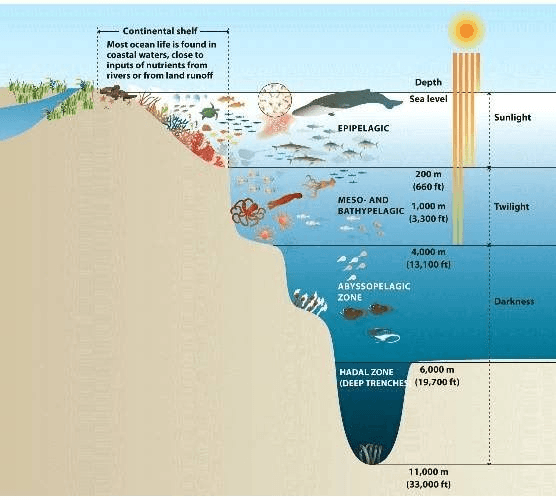
What are producers?
A decrease in this population would be the result of a disease that affected the grasshoppers
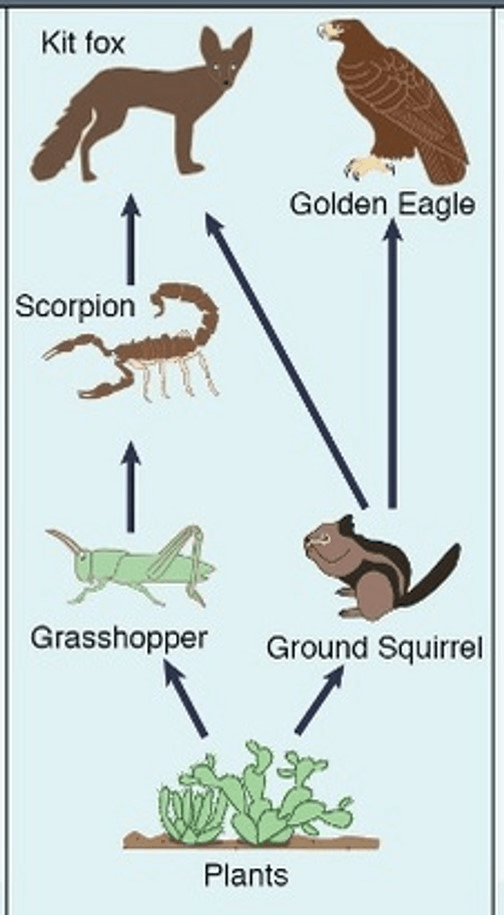
What are the scorpions?
The amount of water on Earth has ____________ over time.
A. increased
B. stayed the same
C. decreased
B. stayed the same
This could be a possible explanation for the change in the mullet population
A. mullet prey increased in the area
B. mullet parasites decreased in the area
C. the temperature of the area increased
D. the amount of aquatic plants in the area decreased
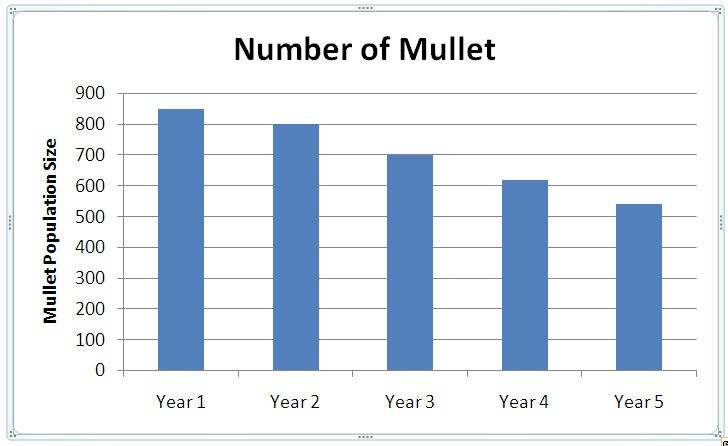
D. the amount of aquatic plants in the area decreased
The presence of wastes like plastic bags and motor oil in lakes and streams miles away from developed areas suggest that . . .
A. recycling programs have failed
B. natural processes can affect ecosystems
C. ecosystems are connected and human action can alter an ecosystem
D. direct harvesting practices have led to an increase in destruction of ecosystems
C. ecosystems are connected and human action can alter an ecosystem
This abiotic factor is produced in photosynthesis in the presence of light, required for all organisms to survive, and breathed in by consumers.
What is oxygen?
How much energy does the fox receive?
A. More from the squirrel than the scorpion
B. The scorpion receives more energy from the grasshopper than from the plants
C. Heat from the grasshopper and the squirrel increase the total amount of energy
D. The amount of energy the eagle receives is less than the amount of energy the plants receive
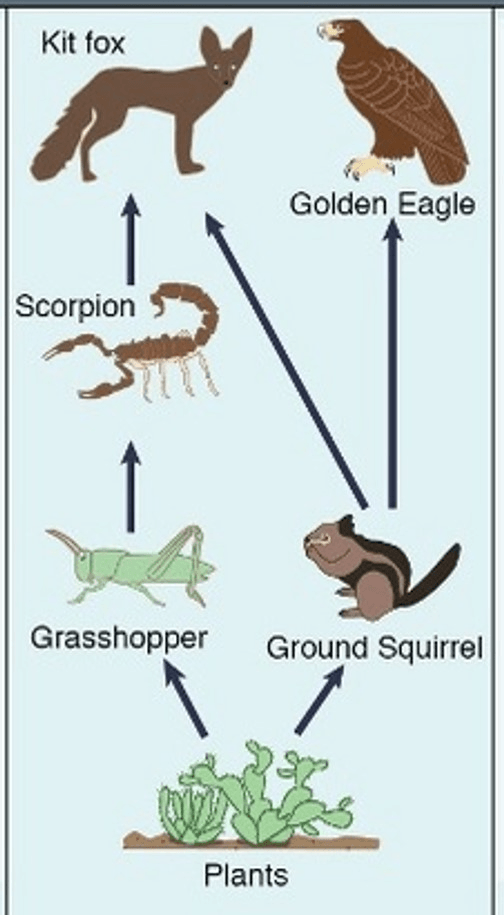
D. The amount of energy the eagle receives is less than the amount of energy the plants receive
What might be the result of a volcanic eruption?
A. Sunlight was blocked by the ash, decreasing in photosynthesis and slowing down the carbon cycle
B. Animals die speeding up the carbon cycle
C. Forests are destroyed increasing decomposition
D. Evaporation increased speeding up water cycle
A. Sunlight was blocked by the ash, decreasing in photosynthesis and slowing down the carbon cycle
If a higher birth rate would increase the carrying capacity, these two things would cause the decrease of a carrying capacity of a population
What are emigration and a higher death rate?
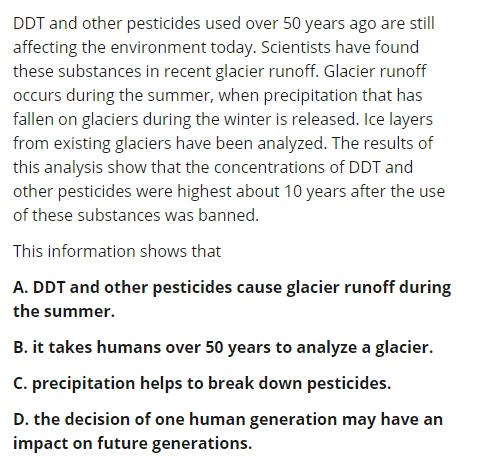
D. the decision of one human generation may have an impact on future generations.
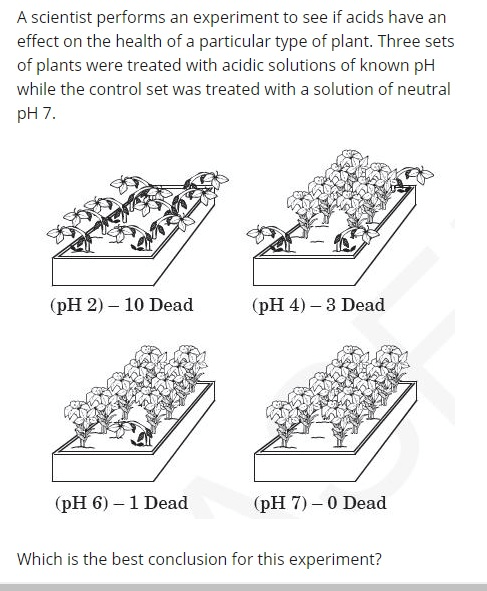
A. Acid has no effect on the health of this plant type.
B. A high pH helps this plant grow.
C. A low pH is harmful to the plant's growth.
D. A neutral pH is harmful to the plant's growth.
C. A low pH is harmful to the plant's growth.